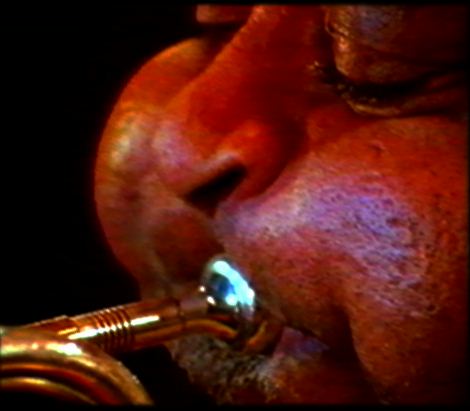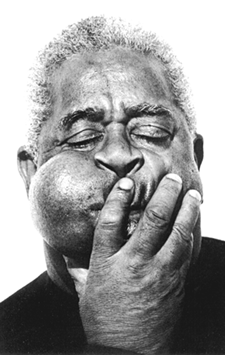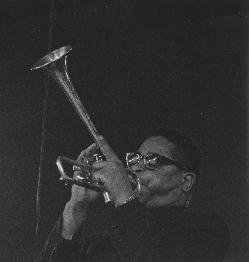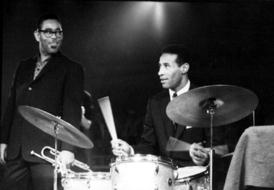
Calendar
of Events
Chesterfield
School District
Cheraw High
Marching Band
Long Middle
School Band
|

 John Birks Gillespie, better known as Dizzy Gillespie, born
on October 21, 1917 in Cheraw, SC, was one of the greatest jazz players
of all times. He was such a complex player that his contemporaries ended
up copying Miles Davis and Fats Navarro instead, and it was not until Jon
Faddis's emergence in the 1970's that Dizzy's style was successfully recreated.
Somehow Gillespie could make any "wrong" note fit and harmonically he was
ahead of of everyone in the 1940's. Dizzy was an enthusiastic teacher who
wrote down his musical innovations and was eager to explain them to the
next generation thereby insuring that bebop would eventually become the
foundation of jazz.
Dizzy was also one of the key founders of Afro-Cuban jazz which
required complex polyrhythms. The leader of two of the finest big bands
in jazz history, Gillespie differed from many in the bop generation by
being a masterful showman who could make his music seem both accessible
and fun to the audience. With his puffed-out cheeks, bent trumpet, which
occurred by acciedent in the early '50s whena dancer tripped over his horn,
and quick wit, Dizzy was a colorful figure to watch. Not was Dizzy a musician,
but a natural comedian that was also superb at scat singing and occasionally
playing Latin percussion for the fun of it. It was his trumpet playing
and leadership abilities that made him into a jazz giant.
John Birks Gillespie, better known as Dizzy Gillespie, born
on October 21, 1917 in Cheraw, SC, was one of the greatest jazz players
of all times. He was such a complex player that his contemporaries ended
up copying Miles Davis and Fats Navarro instead, and it was not until Jon
Faddis's emergence in the 1970's that Dizzy's style was successfully recreated.
Somehow Gillespie could make any "wrong" note fit and harmonically he was
ahead of of everyone in the 1940's. Dizzy was an enthusiastic teacher who
wrote down his musical innovations and was eager to explain them to the
next generation thereby insuring that bebop would eventually become the
foundation of jazz.
Dizzy was also one of the key founders of Afro-Cuban jazz which
required complex polyrhythms. The leader of two of the finest big bands
in jazz history, Gillespie differed from many in the bop generation by
being a masterful showman who could make his music seem both accessible
and fun to the audience. With his puffed-out cheeks, bent trumpet, which
occurred by acciedent in the early '50s whena dancer tripped over his horn,
and quick wit, Dizzy was a colorful figure to watch. Not was Dizzy a musician,
but a natural comedian that was also superb at scat singing and occasionally
playing Latin percussion for the fun of it. It was his trumpet playing
and leadership abilities that made him into a jazz giant.
 The youngest of nine children, Dizzy taught himself trombone and
then switched to trumpet when he was 12. He grew up in poverty, won a scholarship
to an agricultural school, the Lauringburg Institute of North Carolina,
and then dropped out in 1935 to look for work as a musician. Inspired and
initially greatly influenced by Roy Eldridge, Gillespie joined Frankie
Fairfax's band in Philadelphia. In 1937 he became a member of Teddy Hill's
Orchestra in a spot formerly filled by Eldridge. Dizzy made his recording
debut on Hill's rendition of "King Porter Stomp" and during his short period
with the band toured Europe. After freelancing for a year, Gillespie joined
Cab Calloway's Orchestra(1939-41), recording frequently with the popular
bandleader and taking many short solos that trace his development. However,
Calloway did not care for Gillespie's constant chancetaking, calling his
solos "Chinese music" and after an incident in 1941, Dizzy was fired. From
1941-43, Dizzy passed through many bands including those led by Ella Fitzgerals,
Coleman Hawkins, Benny Carter, and even Duke Ellington.
In 1942, Gillespie joined Earl Hines's big band where he was joined
by Charlie Parker on tenor. With this sadly unrecorded orchestra, Dizzy
explored early bebop. By this time, Dizzy had his style together and he
wrote his most famous composition, "A Night in Tunisa."
The youngest of nine children, Dizzy taught himself trombone and
then switched to trumpet when he was 12. He grew up in poverty, won a scholarship
to an agricultural school, the Lauringburg Institute of North Carolina,
and then dropped out in 1935 to look for work as a musician. Inspired and
initially greatly influenced by Roy Eldridge, Gillespie joined Frankie
Fairfax's band in Philadelphia. In 1937 he became a member of Teddy Hill's
Orchestra in a spot formerly filled by Eldridge. Dizzy made his recording
debut on Hill's rendition of "King Porter Stomp" and during his short period
with the band toured Europe. After freelancing for a year, Gillespie joined
Cab Calloway's Orchestra(1939-41), recording frequently with the popular
bandleader and taking many short solos that trace his development. However,
Calloway did not care for Gillespie's constant chancetaking, calling his
solos "Chinese music" and after an incident in 1941, Dizzy was fired. From
1941-43, Dizzy passed through many bands including those led by Ella Fitzgerals,
Coleman Hawkins, Benny Carter, and even Duke Ellington.
In 1942, Gillespie joined Earl Hines's big band where he was joined
by Charlie Parker on tenor. With this sadly unrecorded orchestra, Dizzy
explored early bebop. By this time, Dizzy had his style together and he
wrote his most famous composition, "A Night in Tunisa."

 Dizzy and
his drummer Roach.
List of Dizzy's
Greatest Albums
1945 was the breakthrough year for Dizzy. He had led earlier bands
on 52nd Street, but he finally teamed up with Charlie Parker on records.
Their recordings of such numbers as "Salt Peanuts," "'Shaw Nuff," "Groovin'
High" and "Hot House" confused swing fans who had never heard the advanced
music as it was evolving and Dizzy's rendition of "I Can't Get Started"
completely reworked the former Bunny Berigan hit. It would take two years
for the often-frantic but ultimately logical new style to start catching
on as the mainstream of jazz. Gillespie led an unsuccessful big band in
1945 and late in the year he travelled with Parker to the West Coast to
play a lengthy gig at Billy Berg's club in L.A. Unfortunately the audiences
were not enthusiastic and Dizzy soon returned to New York.
The following year, Dizzy put together a successful and influential
orchestra which survived for nearly four memorable years. "Manteca" became
a standard, the exciting "Things to Come" was futuristic and "Cubana Be/Cubana
Bop" featured Chano Pozo. With such sidemen as the future original members
of the Modern Jazz Quartet, Gillespie's big band was a breeding ground
for the new music. Dizzy's beret, goatee and "bop glasses" helped make
him a symbol of the music and its most popular figure. During 1948-49,
nearly every former swing band was trying to play bop and for a brief period
the major record companies tried very hard to turn the music into a fad. Dizzy and
his drummer Roach.
List of Dizzy's
Greatest Albums
1945 was the breakthrough year for Dizzy. He had led earlier bands
on 52nd Street, but he finally teamed up with Charlie Parker on records.
Their recordings of such numbers as "Salt Peanuts," "'Shaw Nuff," "Groovin'
High" and "Hot House" confused swing fans who had never heard the advanced
music as it was evolving and Dizzy's rendition of "I Can't Get Started"
completely reworked the former Bunny Berigan hit. It would take two years
for the often-frantic but ultimately logical new style to start catching
on as the mainstream of jazz. Gillespie led an unsuccessful big band in
1945 and late in the year he travelled with Parker to the West Coast to
play a lengthy gig at Billy Berg's club in L.A. Unfortunately the audiences
were not enthusiastic and Dizzy soon returned to New York.
The following year, Dizzy put together a successful and influential
orchestra which survived for nearly four memorable years. "Manteca" became
a standard, the exciting "Things to Come" was futuristic and "Cubana Be/Cubana
Bop" featured Chano Pozo. With such sidemen as the future original members
of the Modern Jazz Quartet, Gillespie's big band was a breeding ground
for the new music. Dizzy's beret, goatee and "bop glasses" helped make
him a symbol of the music and its most popular figure. During 1948-49,
nearly every former swing band was trying to play bop and for a brief period
the major record companies tried very hard to turn the music into a fad.
 By 1950, the fad had ended and Gillespie was forced due to economic
pressures to break up his groundbreaking orchestra. He had occasional reunions
with Charlie Parker up until 1955, toured with Jazz at the Philharmonic,
headed all-star recording sessions, and led combos that for a time in 1951
also featured Coltrane and Milt Jackson. In 1956, Gillespie was authorized
to form a big band and play a tour overseas sponsored by the State Department.
It was so successful that more traveling followed including extensive tours
to the Near East, Europe and South America, and the band survived up to
1958. Among the young sidemen were Lee Morgan, Joe Gordon, Benny Golson
and Wynton Kelly; Quincy Jones contributed some of the arrangements. After
the orchestra broke up, Gillespie went back to leading small groups, featuring
such sidemen in the 1960's as Junior Mance and Leo Wright. He retained
his popularity, occasionally headed specially assembled big bands and was
a fixture at jazz festivals. In the early 70', Gillespie toured with the
Giants of Jazz and around that time his trumpet playing began to fade,
a gradual decline that would make most of his 1980s work quite erratic.
However, Dizzy remained a world traveler, and inspiration and teacher to
younger players, and during his last couple of years he was the leader
of the United Nation Orchestra. He stayed active in jazz up until early
1992.
John "Dizzy" Birks Gillespie died on January 7, 1993. He will always
be remembered for his accomplishments in music.
By 1950, the fad had ended and Gillespie was forced due to economic
pressures to break up his groundbreaking orchestra. He had occasional reunions
with Charlie Parker up until 1955, toured with Jazz at the Philharmonic,
headed all-star recording sessions, and led combos that for a time in 1951
also featured Coltrane and Milt Jackson. In 1956, Gillespie was authorized
to form a big band and play a tour overseas sponsored by the State Department.
It was so successful that more traveling followed including extensive tours
to the Near East, Europe and South America, and the band survived up to
1958. Among the young sidemen were Lee Morgan, Joe Gordon, Benny Golson
and Wynton Kelly; Quincy Jones contributed some of the arrangements. After
the orchestra broke up, Gillespie went back to leading small groups, featuring
such sidemen in the 1960's as Junior Mance and Leo Wright. He retained
his popularity, occasionally headed specially assembled big bands and was
a fixture at jazz festivals. In the early 70', Gillespie toured with the
Giants of Jazz and around that time his trumpet playing began to fade,
a gradual decline that would make most of his 1980s work quite erratic.
However, Dizzy remained a world traveler, and inspiration and teacher to
younger players, and during his last couple of years he was the leader
of the United Nation Orchestra. He stayed active in jazz up until early
1992.
John "Dizzy" Birks Gillespie died on January 7, 1993. He will always
be remembered for his accomplishments in music.

|
Please send Questions or Comments
|
Copyright (c) 2002 Cheraw, South Carolina School Bands.
This page was last updated on August 30, 2002
_______________________________________________
Webmaster
|



 Dizzy and
his drummer Roach.
Dizzy and
his drummer Roach.



 Dizzy and
his drummer Roach.
Dizzy and
his drummer Roach.